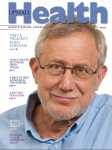Rolling iPads and sign language are part of her job

Sue Freeman, center, communicates via American sign language in an instructional video demonstrating the interpreting services available at Upstate. Also appearing are Upstate employees Priscilla Santana, left, and Rod Freeman, right, who are both looking at an iPad set up as an "interpreter on wheels." English, Spanish and ASL versions of the video can be found on Upstate's YouTube channel (see below for links).
A desire to communicate with a deaf acquaintance led Sue Freeman from her old job in the insurance business to a new career.
Now, as manager of interpreting services at Upstate, she not only communicates with deaf people through American sign language (ASL), she oversees interpreting services for any Upstate patients who need help understanding English.
iPad interpreters keep things rolling
When in-person interpreters are not available, patients can receive interpreting services through an “interpreter on wheels.”
That‘s the term for an iPad attached to a rolling stand that can be used to contact interpreters of 240 languages, so patients can communicate with their doctors and other care providers. Live video, similar to Skype, is available for the 35 most popular languages. For the other languages, audio interpreting only – like a phone call – is available, and more languages are constantly being added to the video service.
“People are getting excited about them as they hear about them and see them in action,” Freeman said of the devices.
With the interpreters on wheels, you can contact an interpreter instantly, anytime. The patient can point to the language name (written in both English and the language in question) on the iPad to get things started. If the patient cannot read, the language can be found by the country of origin. Once the patient goes home from the hospital, a related interpreting service called video relay service can be used to set up three-way communication with a doctor and an interpreter.
Communicating with the deaf
ASL is the second most requested language (behind Spanish) for interpretation at Upstate.
“Sign language is a very visual language, so you have to make the concept visual,” Freeman said. Her desire to speak to a friend she met years ago through her church led her to meet other deaf people, to take sign language classes and eventually to get a bachelor‘s degree in ASL/English translation at the National Technical Institute for the Deaf at the Rochester Institute of Technology.
She began going out to interpreting jobs before she left her old job in an insurance company finance department, and she recalls a question she was asked at a Leadership Greater Syracuse workshop: “Do you want to be known as someone who made a difference, or as someone who just went to work every day?
“And every time I went to an (interpreting) assignment, I felt I was making a difference in two people‘s lives,” she said. She got up the courage to leave the insurance job four years ago and began providing interpreting services for deaf people through an agency. She translated into ASL at local colleges, medical appointments, political speeches and concerts, preparing for what might come up in a song by country star Jason Aldean or a talk by Gov. Andrew Cuomo.
Freeman joined Upstate last year.
Video available in 3 languages
The interpretive services department at Upstate has made a video, available on YouTube in three versions, that demonstrates how the service works for a patient trying to communicate with her doctor. Click here to see the version for speakers of English. Click here to see the version for the deaf. Click here to see the version for speakers of Spanish (haga clic aquí para ver la version para hispanohablantes).
 This article appears in the fall 2017 issue of Upstate Health magazine.
This article appears in the fall 2017 issue of Upstate Health magazine. 


